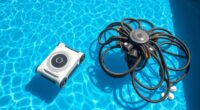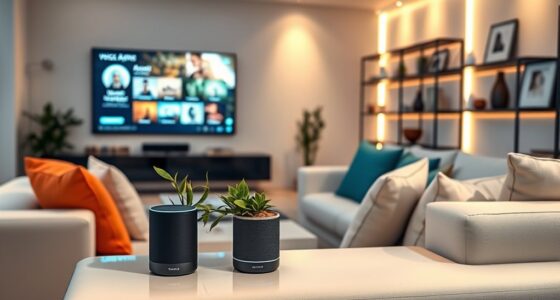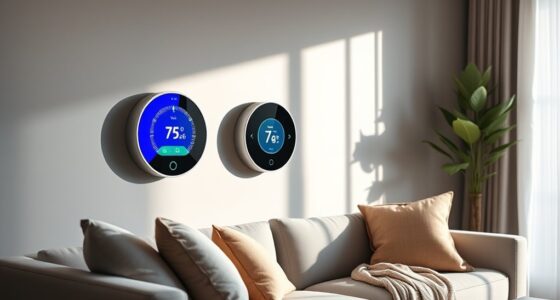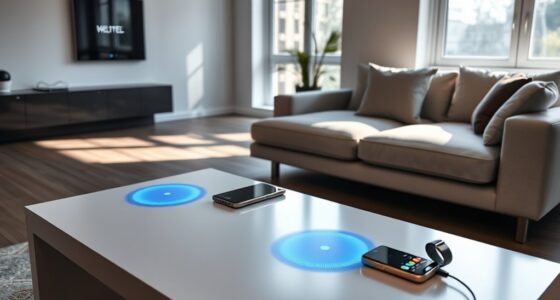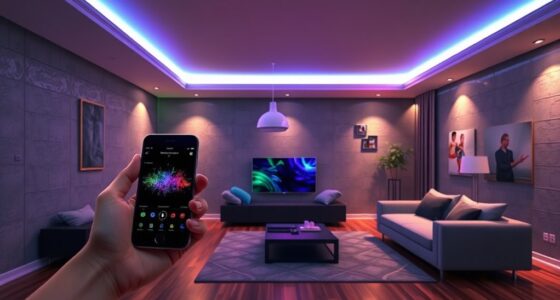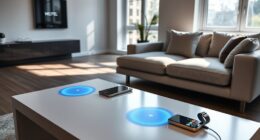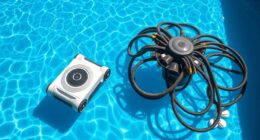Invisible speakers are a smart choice if you want clean, unobtrusive sound without sacrificing style. They seamlessly blend into your walls or ceilings, leaving no bulky hardware or grilles visible. While they deliver clear and focused audio, they may have limited bass and dynamic range compared to traditional systems. Proper installation and finishing are key to achieving a flawless look and sound. Keep exploring to discover how to get the best results for your space.
Key Takeaways
- Invisible speakers blend seamlessly into walls or ceilings, preserving a clean, minimalist aesthetic without visible grilles or bulky hardware.
- They deliver high-fidelity mid and high frequencies, but often require subwoofers for full-range sound and deeper bass.
- Proper installation with professional framing and drywall finishing ensures optimal sound performance and a flawless, concealed look.
- Maintenance and repairs are challenging due to their embedded design, often requiring drywall removal and repainting.
- Ideal for enhancing home decor with discreet audio, but may have limitations in dynamic range and stereo imaging.
How Invisible Speakers Enhance Home Aesthetics
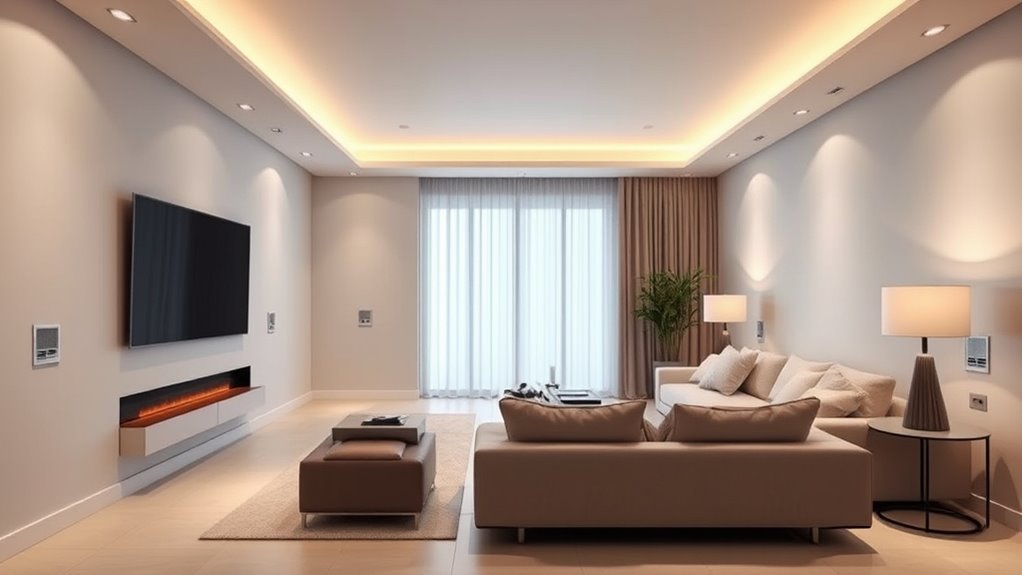
Invisible speakers seamlessly blend into your home’s design, allowing you to enjoy high-quality sound without sacrificing style. Whether installed in the wall or ceiling, these speakers leave no visible grille or bulky hardware, maintaining a clean and uncluttered look. Their flush-mounted design means you can paint or wallpaper over them, ensuring they stay hidden and complement your decor. By eliminating the need for large cabinets, invisible speakers create a sleek, minimalist aesthetic that suits both modern and traditional interiors. Their discreet placement preserves architectural lines and prevents the cluttered appearance often caused by traditional speakers. Additionally, understanding home audio resources can help you choose the best invisible speakers for your space. Using advanced speaker technology, these devices deliver impressive sound quality despite their hidden nature. With invisible speakers, you get seamless sound integration that enhances your space without disrupting your interior design, making them a smart choice for stylish, functional home entertainment. Exploring aesthetic integration techniques can further help you maximize both form and function in your home audio setup. Staying informed about installation options ensures you can correctly position and secure your speakers for optimal performance and durability.
Key Features and Benefits of In-Wall and Invisible Speakers
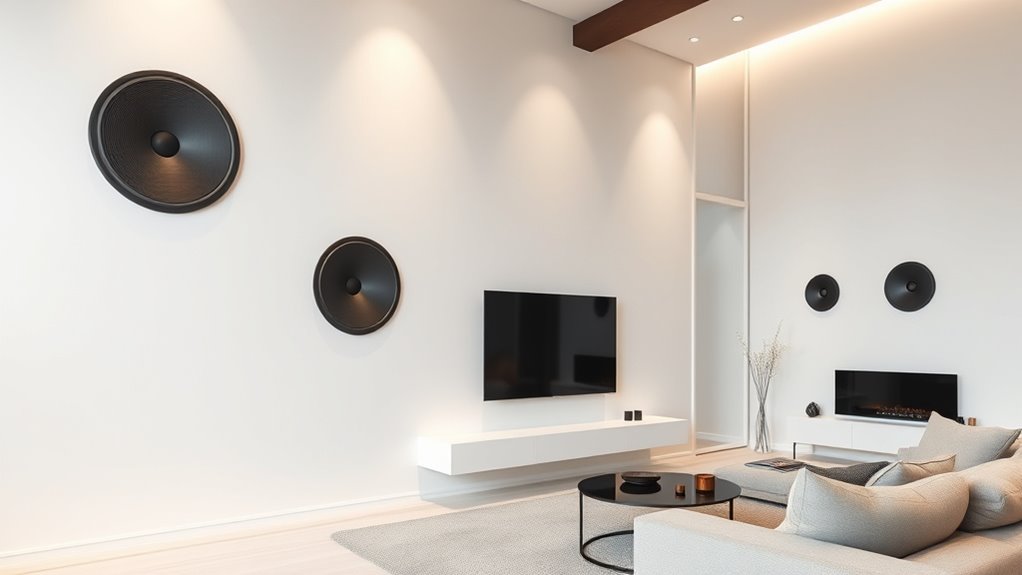
In-wall and invisible speakers are engineered to be embedded seamlessly within your walls or ceilings, providing a sleek and unobtrusive audio experience. These speakers eliminate visible hardware, creating a clean, minimalist look. They often use flat panels or discreet grille covers that can be painted or wallpapered to match your decor. Modern models deliver high-quality sound, rivaling traditional speakers, with cinema-quality audio performance. Their wide dispersion angles (80-90°) ensure broad sound coverage and an expanded listening area. Installation requires professional skills to ensure seamless integration and optimal acoustics. Proper calibration is essential to achieve the best sound quality and consistent performance across your listening space. Here’s a quick overview:
| Feature | Benefit | Notes |
|---|---|---|
| In-wall/invisible design | Sleek, unobtrusive appearance | Blends with your interior |
| High-quality sound | Clear, rich audio performance | Despite concealed nature |
| Wide dispersion angles | Broad sound coverage | Expanded listening experience |
| Customizable covers | Matches decor; painted or wallpapered | Enhances aesthetic appeal |
| Professional installation | Ensures proper fit and sound quality | Needed for best results |
Additionally, integrating these speakers with smart home systems can elevate your audio experience by enabling remote control and automation. Proper placement and sound dispersion are crucial for achieving optimal acoustic performance, creating a more immersive environment. Investing in professional setup not only ensures the best acoustic performance but also maximizes the longevity of your installation. In addition, understanding the importance of speaker placement can significantly impact sound quality and coverage throughout your space.
Common Types and Installation Methods for Hidden Audio Systems
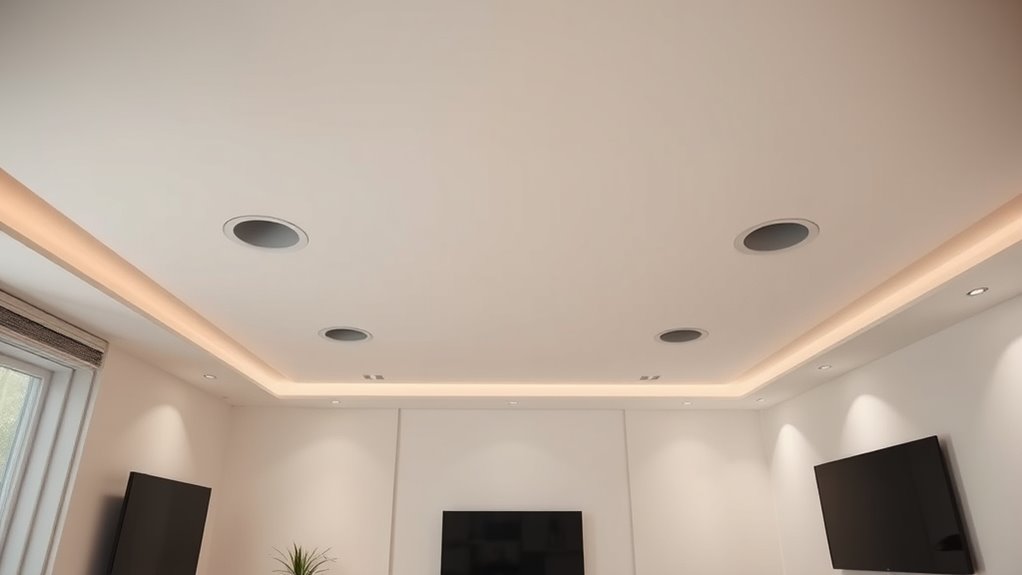
Since seamless integration is key to achieving a clean look, understanding the common types and installation methods of hidden audio systems is essential. In-wall speakers are designed to be mounted flush with walls or ceilings, blending effortlessly once installed. The installation process typically involves prewiring during construction or renovation, followed by precise framing, shimming, and drywall finishing. To hide in-wall speakers effectively, a drywall patch is often used to cover any cutouts, with drywall mud feathered and sanded for a smooth, seamless appearance. Some models feature paintable grilles, making them nearly invisible once painted to match the wall. Because correct installation impacts both aesthetics and sound quality, it’s best to work with professionals who know how to ensure proper drywall finishing and concealment.
Sound Performance and Quality Expectations
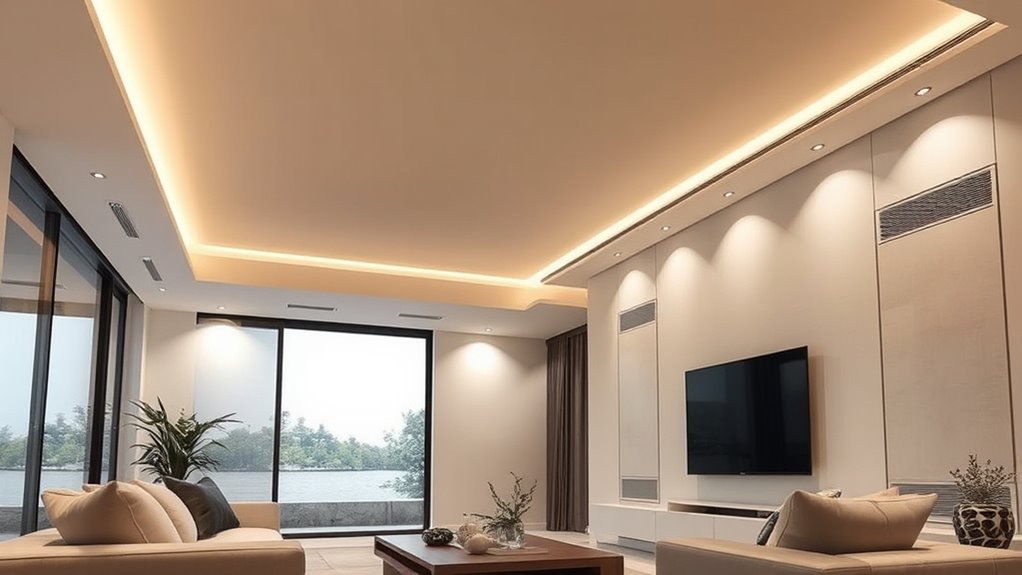
Invisible speakers can deliver clear, focused sound that rivals traditional options when installed correctly. However, their limited bass response means you might need subwoofers for full-range audio. While they excel in mid and high frequencies, they may not provide the sonic depth some critical listening environments require. Recognizing the role of fathers in nurturing confidence and support can enhance your appreciation of quality sound experiences at home. Proper installation and understanding of sound performance and quality expectations are essential for maximizing the benefits of invisible speakers. Additionally, maintaining the integrity of the installation ensures consistent sound quality over time. Being aware of audio quality standards helps in selecting the right setup for your space. As advancements in AI Entertainment continue, integrating smart audio solutions can further elevate your listening experience.
Clarity and Projection
When installed correctly and paired with the right amplifiers, invisible speakers can deliver crystal-clear audio with remarkable precision. Their flat, vibrating panels produce high-fidelity sound quality with minimal distortion, ensuring every detail is audible. These speakers excel in projection, providing cinema-like clarity and wide coverage thanks to their broad dispersion angle of 80-90°. High-quality models from brands like Sonance and Stealth Acoustics are designed to maximize both clarity and projection, even within their concealed form. While their limited bass output may require supplementary subwoofers for full-range sound, their ability to deliver sharp, immersive audio remains impressive. Proper installation and suitable amplification are key to sound performance in creating a seamless, high-performance listening experience. Additionally, understanding regulatory compliance ensures that your installation adheres to safety and quality standards, maximizing both performance and longevity. Staying informed about AI security vulnerabilities can help prevent potential disruptions or safety issues related to smart audio systems. Moreover, selecting speakers with broad dispersion can further improve sound coverage across your space.
Bass and Frequency Range
Have you noticed that invisible speakers often struggle to produce deep bass? Their limited size and design mean they can’t generate the full range of low-frequency sounds on their own. Typically, their frequency response ranges from about 120Hz to 20kHz, so bass frequencies below 120Hz tend to be less pronounced. Instead, they excel at reproducing midrange and high-frequency sounds with clarity, making vocals and dialogue sound crisp and detailed. To achieve a balanced sound, most setups pair invisible speakers with dedicated subwoofers, filling in the deep bass that these speakers can’t produce. This combination ensures you enjoy full-spectrum audio performance, even if the speakers themselves are less capable of delivering rich, deep bass. Additionally, sound performance and quality expectations are often enhanced by proper calibration and placement of the speakers within a room.
Limitations and Considerations When Choosing Invisible Speakers
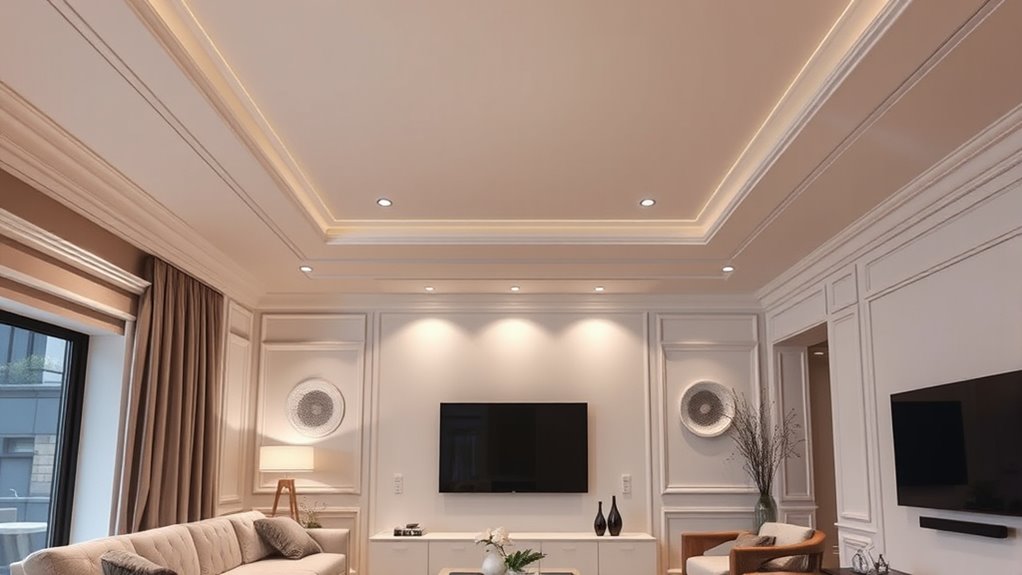
When choosing invisible speakers, you need to contemplate their complex installation process, which can be costly and difficult to reverse. Keep in mind that their sound quality may be limited, especially in bass response and dynamic range, often requiring extra equipment. Additionally, maintenance and repairs can be challenging and expensive due to their discreet design and installation intricacies.
Installation Complexity and Cost
Installing invisible speakers involves more than just mounting them in the wall; it demands precise framing, drywall finishing, and painting, which can substantially increase labor costs and extend installation time. This complexity often requires specialized expertise, making the installation process more costly than traditional options. Expect higher initial investment for premium systems and professional setup. Additionally, repairs are tricky; replacing or fixing them may mean redoing entire wall sections to preserve the seamless look. To visualize the process, consider this:
| Framing & Drywall | Painting | Professional Labor |
|---|---|---|
| Precise fitting | Seamless finish | Skilled technicians |
| Time-consuming | Costly | Increased expenses |
| Essential for aesthetics | Adds to cost | Longer installation |
Sound Quality Limitations
Although invisible speakers offer a sleek, unobtrusive design, they often come with notable sound quality limitations. You might notice less bass response from an in-wall speaker, often needing a subwoofer for full-range sound. Their flat, vibrating panel design limits dynamic range and maximum volume, which can be a drawback for loud listening. The sound dispersion tends to be directional, restricting stereo imaging and reducing soundstage depth—important factors for critical listening. Additionally, the sound quality you experience depends heavily on wall material, mounting accuracy, and the specific model you choose. Invisible speakers generally aren’t suitable for high-performance home theater setups or audiophile-grade music systems. Understanding these limitations helps you set realistic expectations when considering invisible speakers for your space.
Repair and Maintenance Challenges
Repair and maintenance of invisible speakers present unique challenges because accessing the units typically requires removing drywall or repainting, which can be costly and time-consuming. If damage occurs, your options are limited, and repairs often mean replacing the entire panel. Here are key considerations:
- Repairing damage usually involves costly wall removal or repainting.
- Surface patches rarely restore original performance, so full replacement is often necessary.
- Ongoing maintenance is limited due to the sealed, embedded design, making repairs difficult.
- Mechanical failures generally require professional replacement of the entire unit, especially if specialized circuits are involved.
Because of these challenges, you should weigh the convenience of repair and maintenance against the aesthetic benefits of invisible speakers before installation.
Steps to Achieve a Flawless Invisible Speaker Finish

Achieving a flawless invisible speaker finish hinges on meticulous drywall finishing techniques. Start with proper surface preparation by cleaning dust and imperfections from the wall. Use drywall finishing skills like careful taping and feathering joint compound to ensure seamless integration of the speaker panel. Applying multiple thin coats of mud and sanding between layers creates a smooth, crack-free surface, ready for painting or wallpapering. To prevent cracks and maintain an almost invisible look, use shims and ensure the speaker panel is flush with the wallboard. Finish by thoroughly cleaning the surface before painting to eliminate dust and imperfections. Paying close attention to detail during drywall finishing guarantees the speaker remains unobtrusive, blending seamlessly into your wall for a clean, high-quality appearance.
Frequently Asked Questions
Do Invisible Speakers Sound Good?
You might wonder if invisible speakers sound good, and the answer is yes, with some caveats. When installed correctly and powered by quality amplifiers, they deliver clear, high-fidelity sound comparable to traditional speakers, especially in mid and high frequencies. Keep in mind, they often need a subwoofer for full bass. Reputable brands and proper calibration guarantee you get impressive sound, making them a great, discreet audio solution.
How Can I Make My Speakers Sound Clear?
To make your speakers sound clear, start by properly placing and aiming them for even sound distribution. Use high-quality DSP amplifiers and set crossovers around 120Hz to improve clarity. Keep drywall smooth and free of imperfections to prevent muffling, and choose speakers with wide dispersion angles for a uniform sound. Regularly test and fine-tune wiring and connections to avoid phase issues and guarantee your audio remains crisp and clear.
What Is the Difference Between Amina and Sonance Invisible?
You wonder about the difference between Amina and Sonance invisible speakers. Amina uses flat, vibrating panels that are painted over, offering broad sound dispersion and seamless integration. Sonance features thin, flat baffle designs with paintable grilles, focusing on high-fidelity sound and advanced DSP. While Amina emphasizes innovative panel technology and customization, Sonance is known for its proven performance and more complex installation options.
How to Position Speakers for Best Sound?
To position your invisible speakers for the best sound, place them at ear level in the listening area. Space them evenly around the room to avoid dead spots and guarantee balanced coverage. Keep them away from furniture, curtains, or decorations that could muffle sound. Use multiple speakers with overlapping angles to create a wider soundstage. After installation, test and adjust their placement to achieve superior clarity and immersion.
Conclusion
Invisible speakers are like the magic brushstrokes in your home’s masterpiece, seamlessly blending sound and style. They elevate your space without clutter or distraction, creating an immersive audio experience that feels almost invisible. By choosing the right type and installation, you’ll turn your walls into a silent symphony. With a little planning, you’ll enjoy crystal-clear sound as if your music is floating effortlessly through the air—an invisible touch that transforms your home into a sanctuary of sound.

